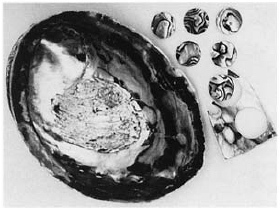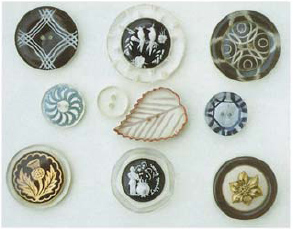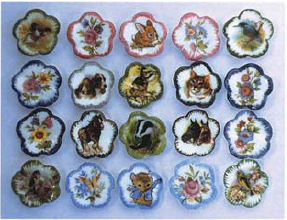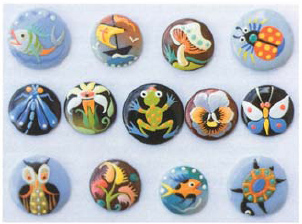Buttons (9 page)
Carved ivory buttons from the late nineteenth/early twentieth century. Colour has been added to accentuate the features of the animal.

Inlaid horn buttons from the nineteenth and early twentieth centuries. (Top) Silver inlay. (Middle row, left and right) Inlay of pearl flowers and metal strands; (centre) silver and pearl chip inlay. (Bottom) Silver inlay.

Leather buttons. (Top row, left to right) Mounted leather; snakeskin; disc of solid leather; snakeskin; mounted leather. (Middle row) Metal head mounted on leather-covered, metal-backed button. (Bottom row, left to right) First and fifth: painted mounted leather on metal; second and fourth: football designs stamped on to leather discs; third: knotted strap of leather.
Home-made
buttons offer the opportunity to create a unique appearance. When needlework was taught in schools, instruction was given in various versions of the Dorset thread button. Decorative embroidery, beadwork or crochet were made to match the prevailing fashion in dress. The Turk’s head knot was adapted to make buttons of cord or braid. Shell buttons could be painted, and plain wooden buttons painted or decorated with barbola work. It is impossible to date home-made buttons, as anyone with the correct materials and skill can reconstruct any style at any time.
Horn and antler
have a porous centre with a surrounding solid layer and textured covering. Sliced horn sew-through buttons have been expertly copied in synthetic material. Both hoof and horn are termed ‘natural plastics’ as they become pliable when heated and retain any moulded shape when cooled. Processed in this way, they can be dyed and stamped with a design and also used as a base for inlay and other decorations. Signs of fibrous layers on the back or the edge, or prick marks on the back of the button, help in identification.
Ivory,
from elephant or walrus tusk, is a very strong, dense material and, unlike bone, has no channel for marrow. It has a narrow, parallel grain lengthwise but a cross-section shows an interlace pattern. It has been used as a base for painting and for very detailed carving, some buttons even having unscrewable ivory shanks. The best examples found today date from around the turn of the nineteenth century and come from China, Japan and India. In the twentieth century buttons, simply shaped, were imported, but the trade in ivory was declared illegal.
Leather
buttons have long been used on gentlemen’s outer garments. The old craft of knotting a thong of leather to create a ball-shaped button, with the pattern resembling a stitched football, has continued with the aid of presses and finishing varnishes. Though there are variations, twentieth-century buttons of this type, with a leather loop shank, were still made from one strap of leather. The design has such a strong tradition that replicas have been made in vegetable ivory, wood, metal and plastics.

Carved pearl buttons from the late eighteenth and nineteenth centuries.

Paua shell from New Zealand, together with buttons and a piece of residue shell. This traditional method of construction of pearl buttons continues.
Papier mâché
is a natural plastic which, although first used in the late eighteenth century, came to prominence in the middle of the nineteenth century for decorative use.
Pearl,
in the sew-through form, has been used for centuries. Production was greatly increased by the introduction of tubular saws in the nineteenth century. Modern plastics, which so closely resemble pearl, are much lighter in weight and are riot subject to the filmy deposit from washing powders which can collect on pearl. In the case of metal-shanked pearl buttons, careful examination of the shank construction can help date the button.
Plastic
is a term used to describe a polymer that can be moulded into a lasting form when heated. It subdivides into natural plastics and man-made plastics. There are other subdivisions according to other properties. After the Second World War the development of man-made plastics progressed rapidly, culminating in the virtually indestructible metalised plastics in use at the end of the twentieth century. Much experimentation took place in the plastics industry and consequently it is not always possible to identify conclusively the exact compound used in any particular button. Care should be taken in storage as some plastics can break down, shown by discoloration, and the fumes given off may cause adjacent metals to deteriorate.
Rubber,
a material used for centuries, became commercially important with the introduction of the vulcanisation process in the middle of the nineteenth century. The Market Harborough Rubber Company produced the Dainite sew-through rubber buttons between 1930 and 1986; these were used on the liberty bodices made by R. & W. H. Symington & Company, also of Market Harborough, Leicestershire.
Studio
buttons can refer to any small-scale production of craftwork buttons but, in general, the term is reserved for buttons made purely to collect rather than use on clothes.
Tortoiseshell,
which actually comes from the shell of turtles, behaves, like horn and hoof, as a natural plastic material. Rarely used on its own as it is so delicate, it has been used on horn as a base for inlay. It has been very skilfully copied in synthetics.

Twentieth-century perspex buttons. (Top row, left and right) Reverse-decorated sew-through; (centre) reverse intaglio decorated disc, screwed into a clear base. (Middle row) A selection of sew-through buttons. (Bottom row, left to right) Reverse-painted disc, glued into a clear base; constructed as centre button on top row with legend ‘L’apprenti Sorrier’ (the sorcerer’s apprentice); painted composition flower, glued to reverse-painted base.

A selection of unmarked twentieth-century ceramic buttons.
Vegetable ivory
resembles ivory but is the egg-sized fruit of the tagua palm, also known as the corozo nut or dom nut. In identification look for small, narrow grain lines and, on the cross-cut face, small dots. Blemishes in the nut show as brown marks. This versatile material could be turned, carved, pressed, dyed or stencilled. It was used to make sew-through or self-shanked buttons, as a base for inlay or, with an inserted loop or pin shank, for the making of overall buttons. It was much used commercially in the last part of the nineteenth century but was replaced by modern synthetics. Production ceased in the 1930s. In the last phase, buttons were made with the skin of the nut incorporated into the design.

A selection of Mack buttons, hand-made by Mack Fine China of Stoke-on-Trent in bone china, with a transfer design and hand-painted rims. These are robust washable buttons, made for the fashion industry since 1985.
